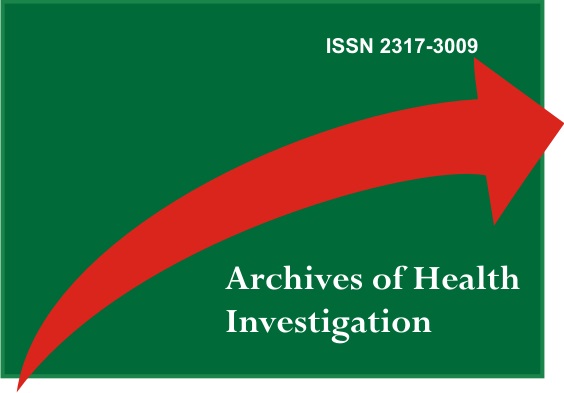Craniocervicomandibular dysfunction with alteration of the VIII cranial pair in muscular dystrophic: case report
DOI:
https://doi.org/10.21270/archi.v10i5.4989Keywords:
Neck Pain, Muscular Dystrophy, Duchenne, Facial Pain, Physical Therapy ModalitiesAbstract
Craniocervicomandibular dysfunction is a common condition, it is believed that two thirds of the population will suffer cervical pain at some point in life. Characterized by cervical pain; limitation of the range of motion of the region; joint noises and muscle tension in the cervical region. Anatomically, the cervical region is the base and support of head and neck structures, and because of its proximity and common innervations, cervical spine disorders may manifest with pain in the orofacial region. When this dysfunction affects a person with severe muscular dystrophic condition, it tends to be much more severe. This study aims to evaluate craniocervicomandibular dysfunction in a patient with Duchenne compatible muscular dystrophy. A 22-year-old male patient attended the Dentistry Polyclinic of the Amazonas State University at the Stomatology Clinic complaining of jaw discomfort, noise and pain. He reported experiencing constant headaches, ear fullness and dizziness. Following clinical examinations, evaluation of temporomandibular disorders and muscle evaluation, the diagnosis of Craniocervicomandibular Dysfunction with Vestibulococleopathy was evidenced. Physiotherapy-associated treatment was initiated to condition an environment for the use of myorelaxant plaque.
Downloads
References
Armijo-Olivo S, Rappoport K, Fuentes J, Gadotti IC, Major PW, Warren S, Thie NM, Magee DJ. Head and cervical posture in patients with temporomandibular disorders. J Orofac Pain. 2011;25(3):199-209.
Moraes FM, Fernandes RSC, Acosta EM. Distrofia Muscular de Duchenne: relato de caso. Rev-Cient-FMC. 2011; 6(2):11-15.
Mokri B, Engel AG. Duchenne dystrophy: electron microscopic findings pointing to a basic or early abnormality in the plasma membrane of the muscle fibre. Neurology. 1975;25(12):111-20.
Schmidt KC, Briesemeister M, Ries LGK. Changes in Mandibular and Cervical Motor Control of Children With Cerebral Palsy. Rev CEFAC. 2014;16(1):228-35.
Moreira AB, Morete M, Cordon F, Malezan WR. Disfunção Temporomandibular e dor Cervical: Comorbidades? Rev Aten Saúde. 2016;14(48):94-8.
Bigaton DR, Silvério KCA, Berni KCS, Distefano G, Forti F, Guirro RRJ. Postura craniocervical em mulheres disfônicas. Rev Soc Bras Fonoaudiol. 2010;15(3):329-34.
Martins BLA, Braga DRLM, Cabral LN. Disfunção massetérica e sialoadenite de refluxo: relato de caso. Arch Health Invest. 2019;8(1):43-7.
Godinho GV, Cabral LN. Disfunção craniocervicomandibular e alterações vestibulococleares: revisão de literatura. Arch Health Invest. 2019;8(8):405-12.
Gama BF, Barros FAM, Cardoso MBSC, Soares MA. Efeito da laserterapia baixa potência em pacientes com disfunção crânio cérvico-mandibular miogênica – análise através da biofotogrametria da biofotogrametria – estudo duplo cego. Persp Online. 2015;17(5):36-46.
Souza I, Oliveira R, Jacques H, Barradas N, Luzes R. A Relação de Coluna Cervical Com a Disfunção Temporomandibular e Seus Principais Sinais e Sintomas. Alumni UNIABEU. 2017;5(9):4-9.
Halmova K, Holly D, Stanko P. The influence of cranio-cervical rehabilitation in patients with myofascial temporomandibular pain disorders. Bratisl Lek Listy. 2017;118(11):710-13.
Silva F, Queiroz A, Serrano K. Alteraciones posturales y su repercusión en el sistema estomatognatico. Acta odontol venez. 2008;46(4):517-22.
Fernandes Neto AJ, Barbosa GA. Placas oclusais. Uberlândia: Universidade Federal de Uberlândia (UFU). 2005. 19 p.
Cruz L, Tegtmeier C, Consiglio M, Barrionuevo L, Correa K. Características clínicas orales en pacientes con distrofia muscular de Duchenne. Estudio descriptivo. Rehabil Integral 2018;13 (2):59-65.
Silva MM, Santos E, Sardelich PL. Distrofia Muscular de Duchenne: repercussões pós treinamento muscular respiratório relato de caso. RUEP. 2016;13(32):84-91.


